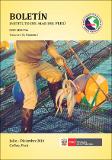Por favor, use este identificador para citar o enlazar este ítem:
https://hdl.handle.net/20.500.12958/3244Registro completo de metadatos
| Campo DC | Valor | Lengua/Idioma |
|---|---|---|
| dc.contributor.author | Bouchon Corrales, Marilú | - |
| dc.contributor.author | Limache, Julio | - |
| dc.contributor.author | Ulloa, Dany | - |
| dc.date | 2018 | Es |
| dc.date.accessioned | 2018-09-10T15:58:31Z | - |
| dc.date.available | 2018-09-10T15:58:31Z | - |
| dc.date.issued | 2018 | - |
| dc.identifier.citation | Bol Inst Mar Perú. 33(2) 2018: p. 212-221 | es_ES |
| dc.identifier.issn | 03787702 | - |
| dc.identifier.uri | https://hdl.handle.net/20.500.12958/3244 | - |
| dc.description.abstract | Analizamos la captura incidental de pota o calamar gigante (Dosidicus gigas) en la pesquería de cerco peruana, entre los años 2000 y 2015. El área de estudio correspondió al espacio comprendido entre los extremos norte y sur del dominio marítimo peruano. Se destaca la mayor captura incidental en la zona norte-centro (Extremo norte – 16°S) siendo significativamente menor al sur de los 16°S. El análisis estacional de captura incidental durante la primera temporada de pesca de la anchoveta, permite determinar que la mayor incidencia de pota se registró entre abril y junio (otoño) que en conjunto significó el 18,67% periodo coincidente con mayor cobertura (10 a 100 mn) y por ende mayor despliegue del esfuerzo pesquero. Durante la pesquería de jurel y caballa, la mayor incidencia se registró entre enero y mayo (verano-otoño), coincidente con la mayor disponibilidad del jurel, con registros hasta 230 millas de la costa. La amplia distribución de la pota en el Perú desde la zona costera hasta más allá de las 200 mn, hace que esté presente como fauna acompañante de las capturas de recursos pelágicos en las diferentes pesquerías, principalmente en el norte del Perú. | es_ES |
| dc.description.abstract | ABSTRACT: We analyzed the bycatch of jumbo flying squid (Dosidicus gigas) in the Peruvian purse-seine fishery between 2000 and 2015. The area of study corresponded to the space between the northern and southern extremes of the 200 mile Peruvian jurisdictional sea. The highest bycatch in the north-central zone (Northern tip - 16°S) is noteworthy, being significantly lower south of 16°S. The analysis of the bycatch during the first fishing season for anchoveta shows that the greatest incidence of jumbo flying squid was recorded between April and June (autumn), which together represented 18.67% of the period coinciding with the greatest coverage (10 to 100 nm) and therefore the greatest deployment of fishing effort. During the fishery for jack and chub mackerel, the highest incidence was recorded between January and May (summer-autumn), coinciding with the highest availability of jack mackerel, with records up to 230 miles from the coast. The wide distribution of D. gigas in Peru from the coastal zone to beyond 200 nm, makes it present as a fauna accompanying the capture of pelagic resources in the different fisheries, mainly in Northern Peru. | - |
| dc.description.sponsorship | Instituto del Mar del Perú | es_ES |
| dc.language.iso | spa | es_ES |
| dc.publisher | Instituto del Mar del Perú | es_ES |
| dc.relation.ispartofseries | Boletín IMARPE;33(2), 2018 | - |
| dc.rights | info:eu-repo/semantics/openAccess | es_ES |
| dc.rights.uri | https://creativecommons.org/licenses/by/4.0/ | es_ES |
| dc.source | Instituto del Mar del Perú - IMARPE | es_ES |
| dc.source.uri | Repositorio Digital IMARPE | es_ES |
| dc.subject | Dosidicus gigas | es_ES |
| dc.subject | Calamar gigante | es_ES |
| dc.subject | Artes de pesca | es_ES |
| dc.subject | Pesca incidental | es_ES |
| dc.subject | Pesqueria de cerco | es_ES |
| dc.title | Captura incidental de la pota (Dosidicus gigas) en la pesquería de cerco peruana | es_ES |
| dc.title.alternative | Bycatch of jumbo flying squid (Dosidicus gigas) in the Peruvian purse-seine fishery | es_ES |
| dc.type | info:eu-repo/semantics/article | es_ES |
| Aparece en las colecciones: | Boletín 33(2), 2018 | |
Ficheros en este ítem:
| Fichero | Descripción | Tamaño | Formato | |
|---|---|---|---|---|
| Boletin 33(2)7.pdf | Captura incidental ... | 1,02 MB | Adobe PDF |  Visualizar/Abrir |
Este ítem está sujeto a una licencia Creative Commons Licencia Creative Commons

